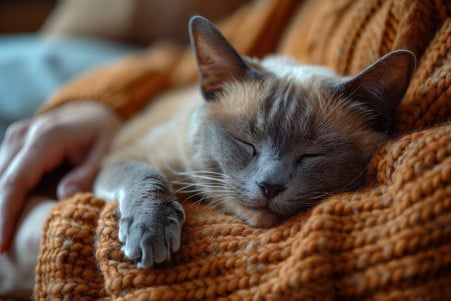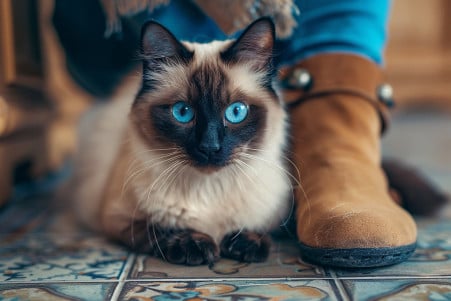How to Tell If Your Cat Is Protective: What It Means to Be Guarded
1 May 2024 • Updated 30 April 2024

Does your cat always seem to be on edge, ready to protect you from any potential danger? While cats are known for their protective behavior, it can be hard to tell if your pet is actually acting as a guardian. The most obvious ways to tell if your cat is protective include over-grooming, defensive stances when others get too close, guarding your personal space, bringing you "prey," and sleeping close to you or in a position that protects you from potential threats.
Despite their independent and sometimes standoffish nature, cats often form strong attachments to their human companions. This article will delve into the research of animal behaviorists, cat specialists, and evolutionary biologists to explain why cats are protective and territorial. By learning about their behaviors and natural instincts, you'll come to understand how your cat is trying to protect you, even if their methods sometimes seem strange to us.
Is your cat being protective of you?
How to Tell If Your Cat Is Protective
Cats communicate in many ways, but a lot of their communication is nonverbal, which can make it hard for humans to understand. When a cat is feeling protective, there are several signs that they are trying to communicate that their protective instincts have kicked in. According to Catster, these signs include a stiff, upright body with an arched back, the hair along the spine and tail standing up, ears that are flat against the head, and a tail that is twitching or lashing from side to side.
Other signs that a cat is being protective, according to Hill's Pet Nutrition, are dilated pupils, wide eyes with a fixed stare, hissing or growling, and swatting or scratching at the threat. As Cats Protection points out, a cat that is very frightened may also show piloerection, which is when the fur stands up to make the cat look bigger and more threatening to potential threats.
It's important to recognize these signs, because a cat's protective body language and "polite" communication, like hissing or growling, can quickly turn into aggression, like biting or scratching, if the threat doesn't go away. If you notice these signs, make sure to give your cat space and don't approach or confront them directly to help prevent the situation from escalating. As VCA Animal Hospitals explains, sudden exposure to a phobia can undo the progress that has been made in desensitization training, so it's important to know and respect your cat's limits.
Territorial Behaviors: Marking and Guarding Their Domain
Cats are territorial animals and may show protective behaviors to protect their territory, which often includes their human family. According to Catster, common territorial marking behaviors include scratching furniture, rubbing against objects to leave scent marks, and unneutered males spraying urine. The Hill's Pet Nutrition article further explains that guarding behaviors can involve blocking access to certain areas, following or shadowing the owner, and positioning themselves between the perceived threat and their territory.
These behaviors are a result of a cat's natural instinct to create and protect a safe, secure environment for themselves and their social group, as PetCareRx points out. It's important to manage these protective behaviors by understanding and addressing the root causes of territorial aggression, such as fear or stress, according to VCA Animal Hospitals. Owners can help by learning to recognize the signs of a cat's territorial nature and working to create a living environment that helps meet their cat's need for security.
Attachment and Affection: Protecting Their People
Cats can become attached to their human caregivers, and protective behaviors can be a sign of this attachment. According to the Humane Society of Greater Dayton, other signs of attachment and affection include purring, kneading, sleeping near or on their owner, bunting (rubbing against their owner), and exposing their belly. Bringing 'gifts' like toys or prey, meowing for attention, and following their owner around are also signs of attachment, according to Catster.
When cats feel protective of their loved ones, they may exhibit guarding behaviors, vocalizations, or even physically step in to protect them from a perceived threat, as explained by Scientific American. Positive reinforcement and working to build a strong relationship can help to encourage protective behaviors in a way that is healthy, according to SHEBA® UK.
Fear and Anxiety: When Protection Turns to Aggression
While protective behaviors can be a sign of a cat's love for their human family, they can also be a sign of fear, anxiety, or stress. According to VCA Animal Hospitals, signs of fear in cats include a crouched posture, flattened ears, dilated pupils, hissing, growling, and attempts to hide or escape. Anxious cats may also show signs of fear, such as excessive grooming, loss of appetite, vocalization, trembling, and inappropriate elimination outside the litter box, according to Catster.
If a cat's fear or anxiety isn't addressed, protective behaviors can become aggressive, including biting, scratching, or swatting. According to PetMD, signs of severe anxiety in cats include actively trying to flee, a "Halloween cat" stance with an arched back and bristled tail, and defensive aggression like flattened ears and paw swats. Cats Protection notes that it's important to recognize and address the root causes of fear and anxiety, including environmental factors and past experiences, in order to manage these aggressive protective behaviors.
Coping With Protective Behaviors: How to Help Your Cat Feel Safe
One way to help reduce the need for protective behaviors is to make sure your cat feels safe, secure, and comfortable in their environment, according to VCA Animal Hospitals. This can be done by establishing a regular routine, providing hiding places and vertical territory, and minimizing stress in the environment. All of these things can help reduce a cat's anxiety and fear. In addition, as Catster and Hill's Pet Nutrition point out, these steps can also help with the root causes of territorial aggression and defensive behaviors.
In addition, positive reinforcement training and desensitization can be used to help reduce aggressive protective behaviors and increase a cat's confidence, according to VCA Animal Hospitals. However, it's important to avoid punishing or rewarding these aggressive behaviors, as doing so can make the problem worse and harm the bond between a person and their cat, according to PetMD.
In some cases, especially when a cat's aggression or fear is deeply ingrained, it may be necessary to work with a certified animal behaviorist, according to Cats Protection. By addressing the root causes of a cat's protective behaviors and making sure they feel safe and secure, pet parents can help their cat embrace their protective instincts in a way that's positive and healthy.
Conclusion: Understanding and Valuing Your Cat's Protection
Although a cat's protective behaviors can be strange and even frustrating at times, they are a product of their instincts and their close bond with their human family. Knowing what drives these behaviors and learning to recognize the signs can help improve the relationship between cats and their human family members and make for a happier home life.
By helping cats feel more secure, working to reduce their anxiety, and rewarding them for positive behaviors, cat owners can help ensure that their cat's protective behaviors are healthy. Understanding and valuing your cat's protection and making sure that they feel safe and secure can help you and your feline friend develop an even closer relationship.


